Strategies for Managing Employee Behavior: Challenges & Solutions
VerifiedAdded on 2023/06/12
|10
|2618
|271
Essay
AI Summary
This essay examines the multifaceted challenges managers encounter in overseeing employee behavior, stemming from factors like globalization, workforce diversity, and ethical considerations. It highlights how globalization necessitates navigating diverse cultural backgrounds and work ethics, while workforce diversity introduces complexities related to age, gender, race, and skills. Ethical dilemmas further complicate the management landscape, requiring managers to foster environments where employees prioritize organizational needs. The essay then proposes strategies for addressing these challenges, including understanding global differences through exchange programs, promoting equality in work activities, providing continuous training in conflict resolution and civility, enhancing communication through clear codes of conduct, and implementing fair disciplinary procedures. Ultimately, it emphasizes the importance of a balanced approach that recognizes the uniqueness of each employee while aligning individual behaviors with organizational goals, contributing to improved organizational performance and a harmonious work environment. Desklib offers a wealth of resources, including similar essays and solved assignments, to aid students in their studies.
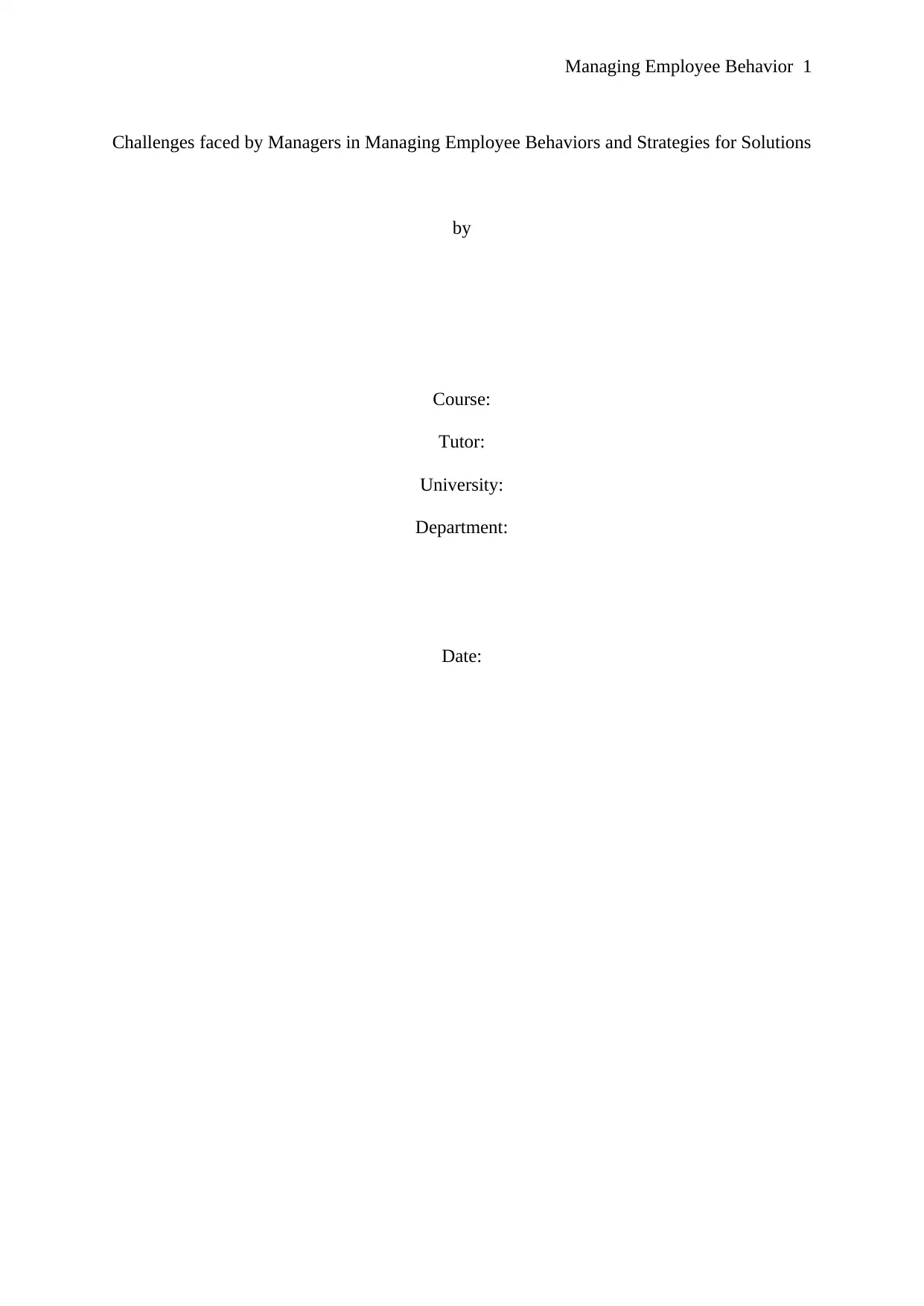
Managing Employee Behavior 1
Challenges faced by Managers in Managing Employee Behaviors and Strategies for Solutions
by
Course:
Tutor:
University:
Department:
Date:
Challenges faced by Managers in Managing Employee Behaviors and Strategies for Solutions
by
Course:
Tutor:
University:
Department:
Date:
Paraphrase This Document
Need a fresh take? Get an instant paraphrase of this document with our AI Paraphraser
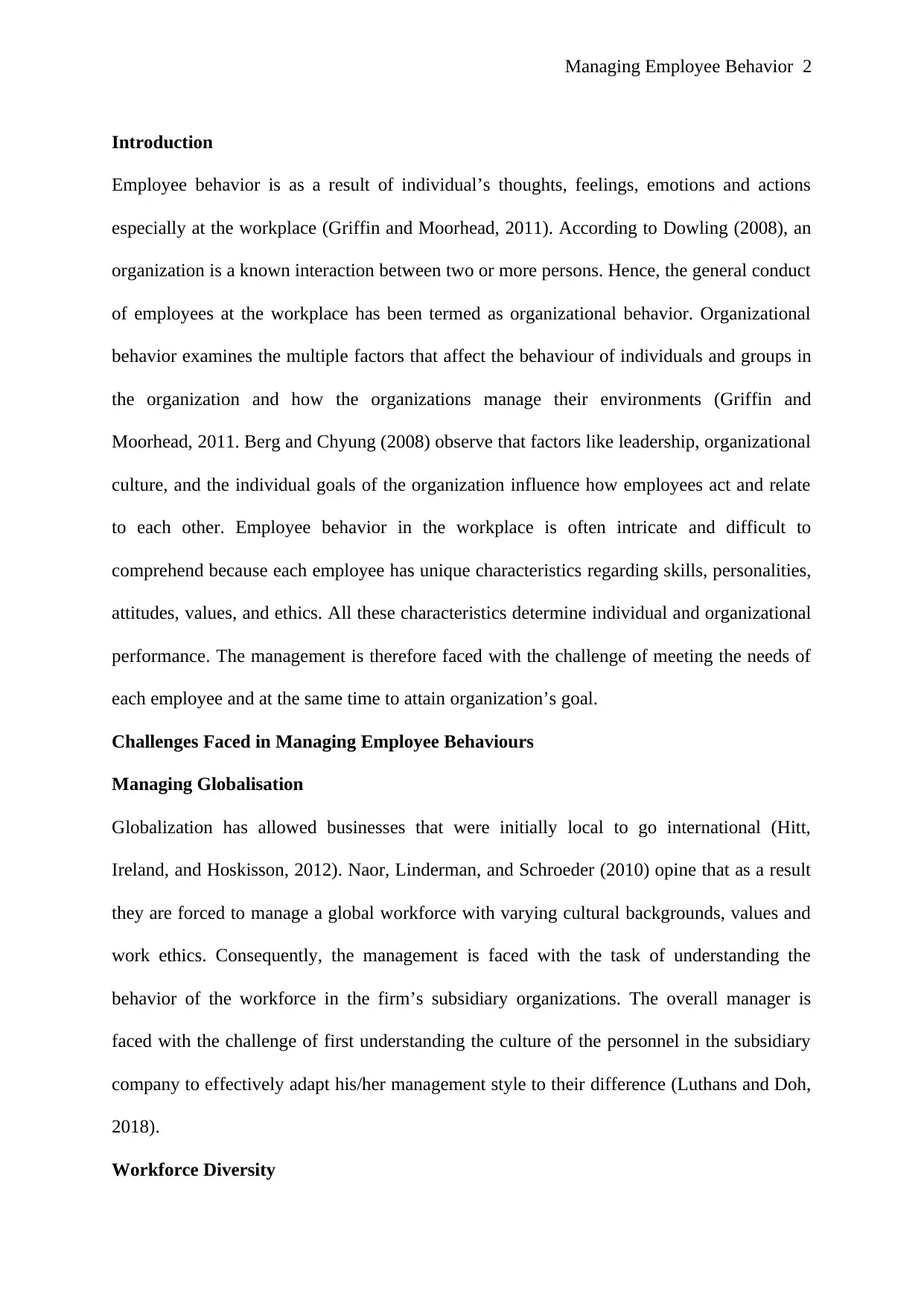
Managing Employee Behavior 2
Introduction
Employee behavior is as a result of individual’s thoughts, feelings, emotions and actions
especially at the workplace (Griffin and Moorhead, 2011). According to Dowling (2008), an
organization is a known interaction between two or more persons. Hence, the general conduct
of employees at the workplace has been termed as organizational behavior. Organizational
behavior examines the multiple factors that affect the behaviour of individuals and groups in
the organization and how the organizations manage their environments (Griffin and
Moorhead, 2011. Berg and Chyung (2008) observe that factors like leadership, organizational
culture, and the individual goals of the organization influence how employees act and relate
to each other. Employee behavior in the workplace is often intricate and difficult to
comprehend because each employee has unique characteristics regarding skills, personalities,
attitudes, values, and ethics. All these characteristics determine individual and organizational
performance. The management is therefore faced with the challenge of meeting the needs of
each employee and at the same time to attain organization’s goal.
Challenges Faced in Managing Employee Behaviours
Managing Globalisation
Globalization has allowed businesses that were initially local to go international (Hitt,
Ireland, and Hoskisson, 2012). Naor, Linderman, and Schroeder (2010) opine that as a result
they are forced to manage a global workforce with varying cultural backgrounds, values and
work ethics. Consequently, the management is faced with the task of understanding the
behavior of the workforce in the firm’s subsidiary organizations. The overall manager is
faced with the challenge of first understanding the culture of the personnel in the subsidiary
company to effectively adapt his/her management style to their difference (Luthans and Doh,
2018).
Workforce Diversity
Introduction
Employee behavior is as a result of individual’s thoughts, feelings, emotions and actions
especially at the workplace (Griffin and Moorhead, 2011). According to Dowling (2008), an
organization is a known interaction between two or more persons. Hence, the general conduct
of employees at the workplace has been termed as organizational behavior. Organizational
behavior examines the multiple factors that affect the behaviour of individuals and groups in
the organization and how the organizations manage their environments (Griffin and
Moorhead, 2011. Berg and Chyung (2008) observe that factors like leadership, organizational
culture, and the individual goals of the organization influence how employees act and relate
to each other. Employee behavior in the workplace is often intricate and difficult to
comprehend because each employee has unique characteristics regarding skills, personalities,
attitudes, values, and ethics. All these characteristics determine individual and organizational
performance. The management is therefore faced with the challenge of meeting the needs of
each employee and at the same time to attain organization’s goal.
Challenges Faced in Managing Employee Behaviours
Managing Globalisation
Globalization has allowed businesses that were initially local to go international (Hitt,
Ireland, and Hoskisson, 2012). Naor, Linderman, and Schroeder (2010) opine that as a result
they are forced to manage a global workforce with varying cultural backgrounds, values and
work ethics. Consequently, the management is faced with the task of understanding the
behavior of the workforce in the firm’s subsidiary organizations. The overall manager is
faced with the challenge of first understanding the culture of the personnel in the subsidiary
company to effectively adapt his/her management style to their difference (Luthans and Doh,
2018).
Workforce Diversity
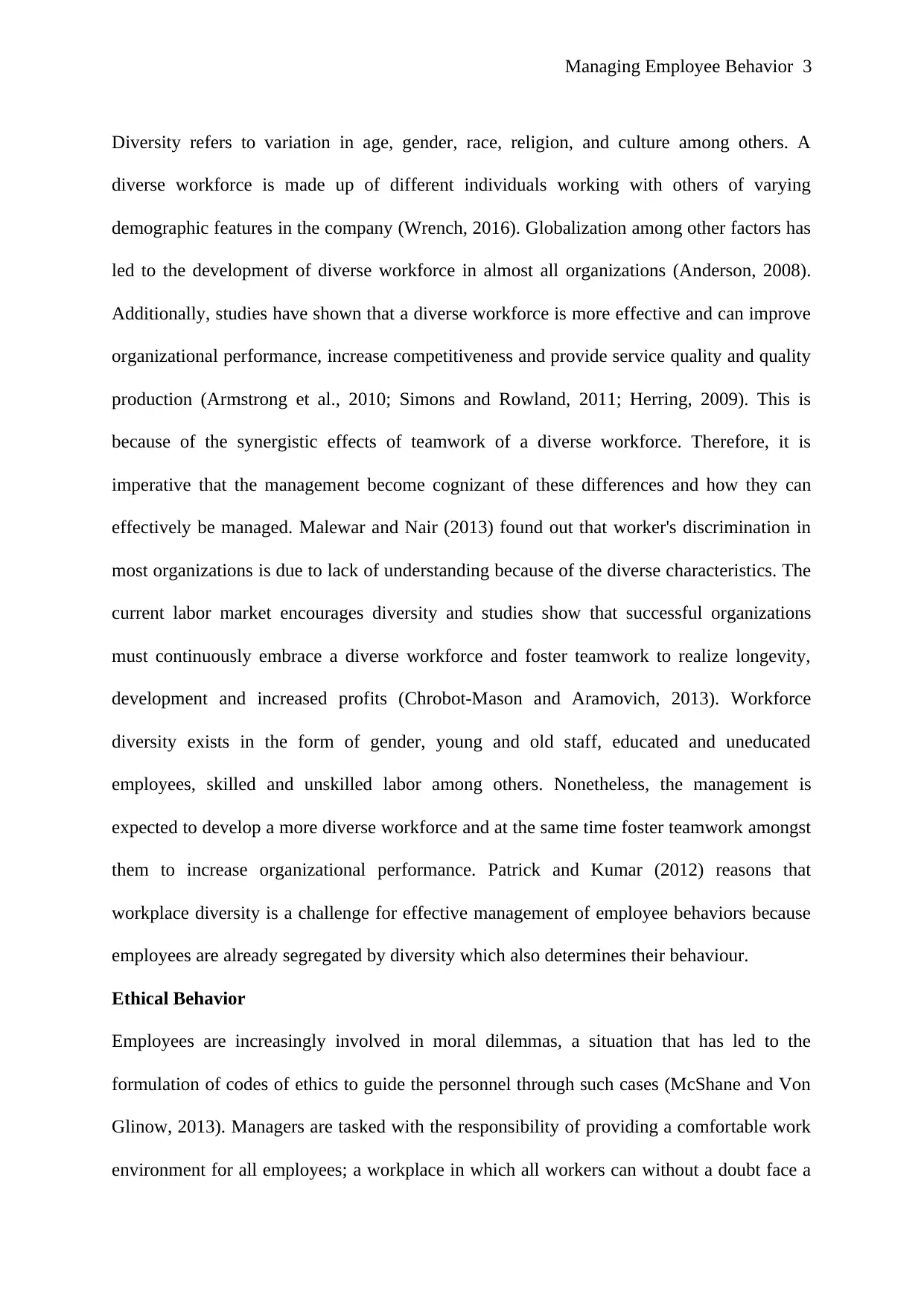
Managing Employee Behavior 3
Diversity refers to variation in age, gender, race, religion, and culture among others. A
diverse workforce is made up of different individuals working with others of varying
demographic features in the company (Wrench, 2016). Globalization among other factors has
led to the development of diverse workforce in almost all organizations (Anderson, 2008).
Additionally, studies have shown that a diverse workforce is more effective and can improve
organizational performance, increase competitiveness and provide service quality and quality
production (Armstrong et al., 2010; Simons and Rowland, 2011; Herring, 2009). This is
because of the synergistic effects of teamwork of a diverse workforce. Therefore, it is
imperative that the management become cognizant of these differences and how they can
effectively be managed. Malewar and Nair (2013) found out that worker's discrimination in
most organizations is due to lack of understanding because of the diverse characteristics. The
current labor market encourages diversity and studies show that successful organizations
must continuously embrace a diverse workforce and foster teamwork to realize longevity,
development and increased profits (Chrobot-Mason and Aramovich, 2013). Workforce
diversity exists in the form of gender, young and old staff, educated and uneducated
employees, skilled and unskilled labor among others. Nonetheless, the management is
expected to develop a more diverse workforce and at the same time foster teamwork amongst
them to increase organizational performance. Patrick and Kumar (2012) reasons that
workplace diversity is a challenge for effective management of employee behaviors because
employees are already segregated by diversity which also determines their behaviour.
Ethical Behavior
Employees are increasingly involved in moral dilemmas, a situation that has led to the
formulation of codes of ethics to guide the personnel through such cases (McShane and Von
Glinow, 2013). Managers are tasked with the responsibility of providing a comfortable work
environment for all employees; a workplace in which all workers can without a doubt face a
Diversity refers to variation in age, gender, race, religion, and culture among others. A
diverse workforce is made up of different individuals working with others of varying
demographic features in the company (Wrench, 2016). Globalization among other factors has
led to the development of diverse workforce in almost all organizations (Anderson, 2008).
Additionally, studies have shown that a diverse workforce is more effective and can improve
organizational performance, increase competitiveness and provide service quality and quality
production (Armstrong et al., 2010; Simons and Rowland, 2011; Herring, 2009). This is
because of the synergistic effects of teamwork of a diverse workforce. Therefore, it is
imperative that the management become cognizant of these differences and how they can
effectively be managed. Malewar and Nair (2013) found out that worker's discrimination in
most organizations is due to lack of understanding because of the diverse characteristics. The
current labor market encourages diversity and studies show that successful organizations
must continuously embrace a diverse workforce and foster teamwork to realize longevity,
development and increased profits (Chrobot-Mason and Aramovich, 2013). Workforce
diversity exists in the form of gender, young and old staff, educated and uneducated
employees, skilled and unskilled labor among others. Nonetheless, the management is
expected to develop a more diverse workforce and at the same time foster teamwork amongst
them to increase organizational performance. Patrick and Kumar (2012) reasons that
workplace diversity is a challenge for effective management of employee behaviors because
employees are already segregated by diversity which also determines their behaviour.
Ethical Behavior
Employees are increasingly involved in moral dilemmas, a situation that has led to the
formulation of codes of ethics to guide the personnel through such cases (McShane and Von
Glinow, 2013). Managers are tasked with the responsibility of providing a comfortable work
environment for all employees; a workplace in which all workers can without a doubt face a
⊘ This is a preview!⊘
Do you want full access?
Subscribe today to unlock all pages.

Trusted by 1+ million students worldwide
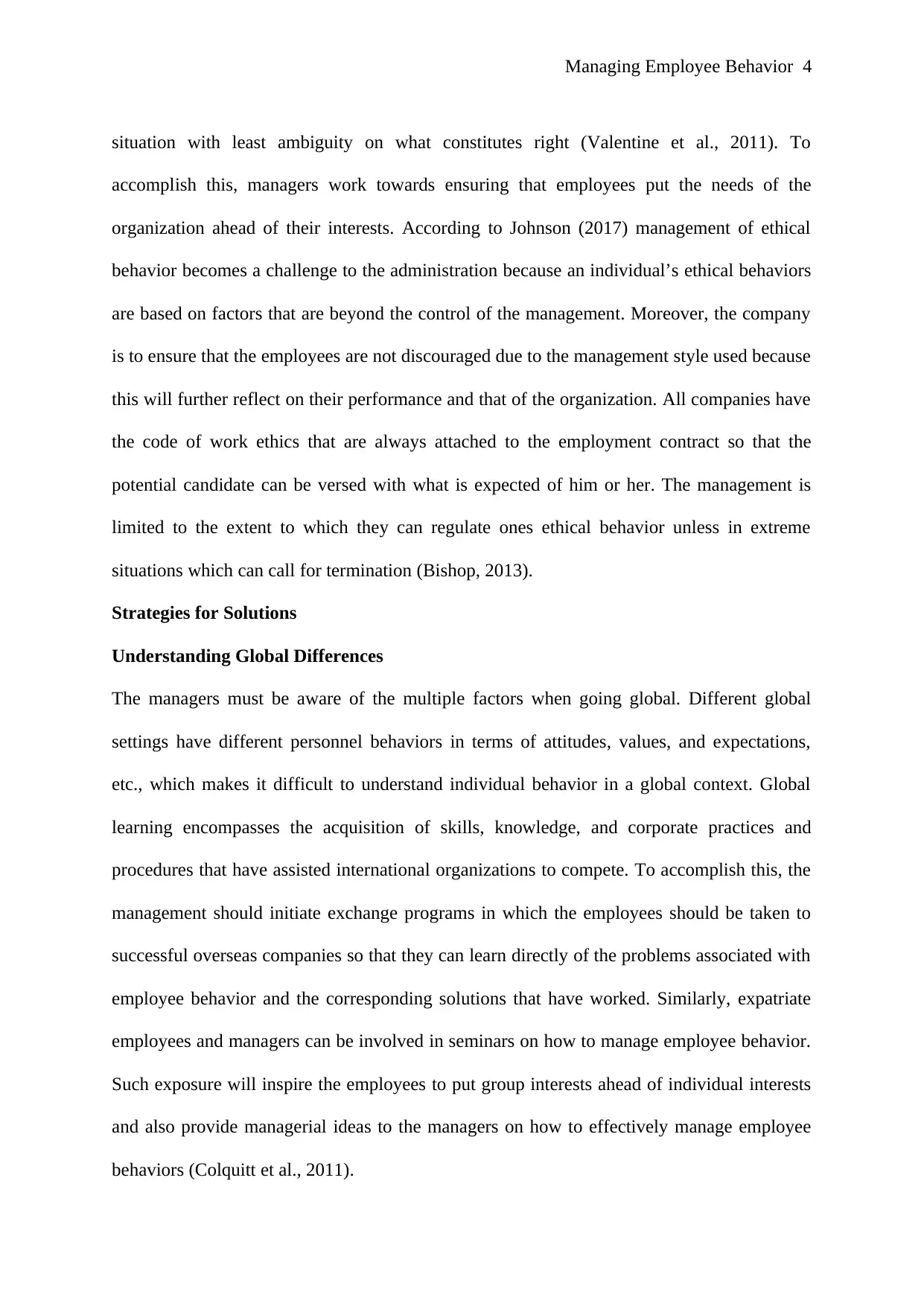
Managing Employee Behavior 4
situation with least ambiguity on what constitutes right (Valentine et al., 2011). To
accomplish this, managers work towards ensuring that employees put the needs of the
organization ahead of their interests. According to Johnson (2017) management of ethical
behavior becomes a challenge to the administration because an individual’s ethical behaviors
are based on factors that are beyond the control of the management. Moreover, the company
is to ensure that the employees are not discouraged due to the management style used because
this will further reflect on their performance and that of the organization. All companies have
the code of work ethics that are always attached to the employment contract so that the
potential candidate can be versed with what is expected of him or her. The management is
limited to the extent to which they can regulate ones ethical behavior unless in extreme
situations which can call for termination (Bishop, 2013).
Strategies for Solutions
Understanding Global Differences
The managers must be aware of the multiple factors when going global. Different global
settings have different personnel behaviors in terms of attitudes, values, and expectations,
etc., which makes it difficult to understand individual behavior in a global context. Global
learning encompasses the acquisition of skills, knowledge, and corporate practices and
procedures that have assisted international organizations to compete. To accomplish this, the
management should initiate exchange programs in which the employees should be taken to
successful overseas companies so that they can learn directly of the problems associated with
employee behavior and the corresponding solutions that have worked. Similarly, expatriate
employees and managers can be involved in seminars on how to manage employee behavior.
Such exposure will inspire the employees to put group interests ahead of individual interests
and also provide managerial ideas to the managers on how to effectively manage employee
behaviors (Colquitt et al., 2011).
situation with least ambiguity on what constitutes right (Valentine et al., 2011). To
accomplish this, managers work towards ensuring that employees put the needs of the
organization ahead of their interests. According to Johnson (2017) management of ethical
behavior becomes a challenge to the administration because an individual’s ethical behaviors
are based on factors that are beyond the control of the management. Moreover, the company
is to ensure that the employees are not discouraged due to the management style used because
this will further reflect on their performance and that of the organization. All companies have
the code of work ethics that are always attached to the employment contract so that the
potential candidate can be versed with what is expected of him or her. The management is
limited to the extent to which they can regulate ones ethical behavior unless in extreme
situations which can call for termination (Bishop, 2013).
Strategies for Solutions
Understanding Global Differences
The managers must be aware of the multiple factors when going global. Different global
settings have different personnel behaviors in terms of attitudes, values, and expectations,
etc., which makes it difficult to understand individual behavior in a global context. Global
learning encompasses the acquisition of skills, knowledge, and corporate practices and
procedures that have assisted international organizations to compete. To accomplish this, the
management should initiate exchange programs in which the employees should be taken to
successful overseas companies so that they can learn directly of the problems associated with
employee behavior and the corresponding solutions that have worked. Similarly, expatriate
employees and managers can be involved in seminars on how to manage employee behavior.
Such exposure will inspire the employees to put group interests ahead of individual interests
and also provide managerial ideas to the managers on how to effectively manage employee
behaviors (Colquitt et al., 2011).
Paraphrase This Document
Need a fresh take? Get an instant paraphrase of this document with our AI Paraphraser
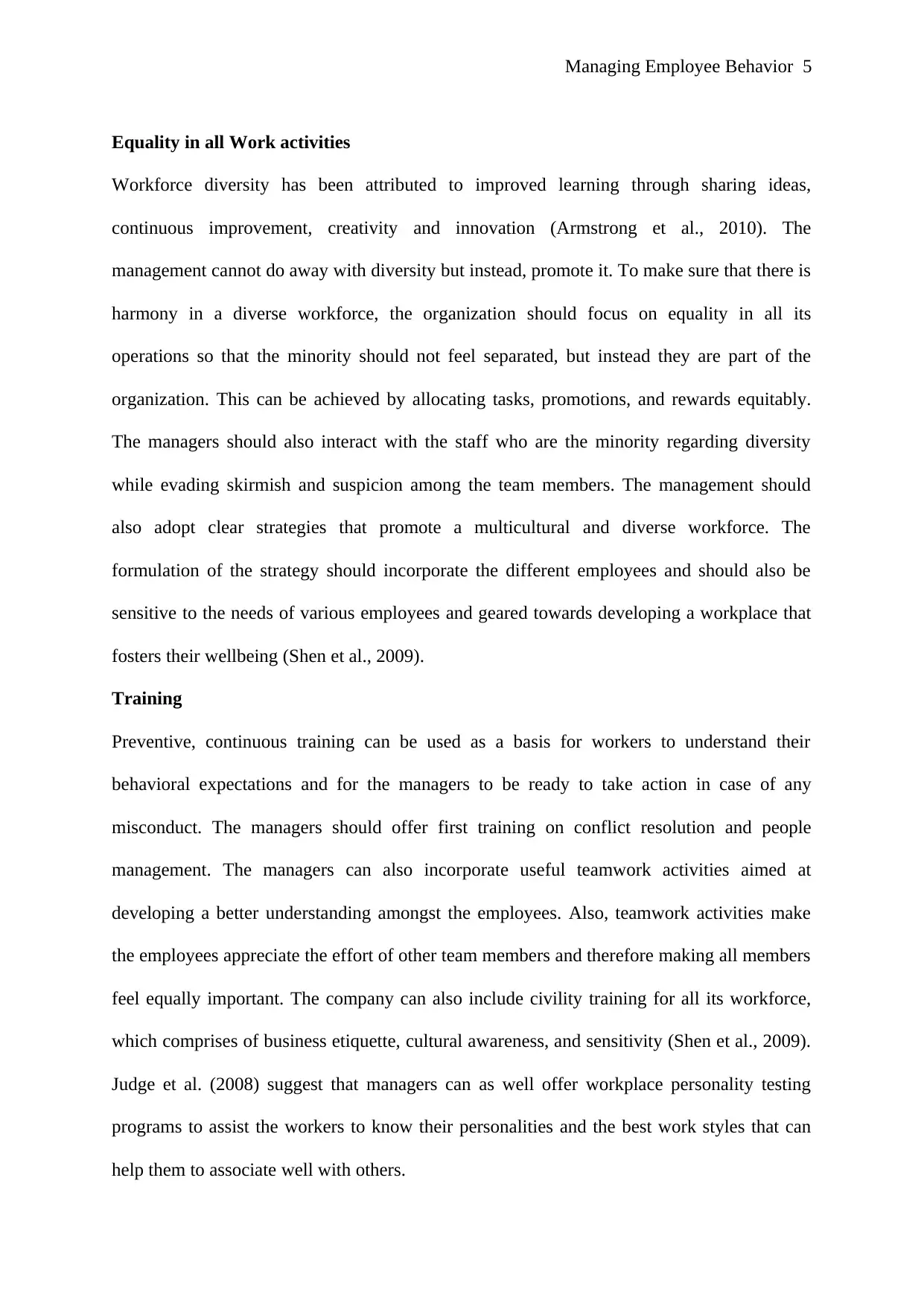
Managing Employee Behavior 5
Equality in all Work activities
Workforce diversity has been attributed to improved learning through sharing ideas,
continuous improvement, creativity and innovation (Armstrong et al., 2010). The
management cannot do away with diversity but instead, promote it. To make sure that there is
harmony in a diverse workforce, the organization should focus on equality in all its
operations so that the minority should not feel separated, but instead they are part of the
organization. This can be achieved by allocating tasks, promotions, and rewards equitably.
The managers should also interact with the staff who are the minority regarding diversity
while evading skirmish and suspicion among the team members. The management should
also adopt clear strategies that promote a multicultural and diverse workforce. The
formulation of the strategy should incorporate the different employees and should also be
sensitive to the needs of various employees and geared towards developing a workplace that
fosters their wellbeing (Shen et al., 2009).
Training
Preventive, continuous training can be used as a basis for workers to understand their
behavioral expectations and for the managers to be ready to take action in case of any
misconduct. The managers should offer first training on conflict resolution and people
management. The managers can also incorporate useful teamwork activities aimed at
developing a better understanding amongst the employees. Also, teamwork activities make
the employees appreciate the effort of other team members and therefore making all members
feel equally important. The company can also include civility training for all its workforce,
which comprises of business etiquette, cultural awareness, and sensitivity (Shen et al., 2009).
Judge et al. (2008) suggest that managers can as well offer workplace personality testing
programs to assist the workers to know their personalities and the best work styles that can
help them to associate well with others.
Equality in all Work activities
Workforce diversity has been attributed to improved learning through sharing ideas,
continuous improvement, creativity and innovation (Armstrong et al., 2010). The
management cannot do away with diversity but instead, promote it. To make sure that there is
harmony in a diverse workforce, the organization should focus on equality in all its
operations so that the minority should not feel separated, but instead they are part of the
organization. This can be achieved by allocating tasks, promotions, and rewards equitably.
The managers should also interact with the staff who are the minority regarding diversity
while evading skirmish and suspicion among the team members. The management should
also adopt clear strategies that promote a multicultural and diverse workforce. The
formulation of the strategy should incorporate the different employees and should also be
sensitive to the needs of various employees and geared towards developing a workplace that
fosters their wellbeing (Shen et al., 2009).
Training
Preventive, continuous training can be used as a basis for workers to understand their
behavioral expectations and for the managers to be ready to take action in case of any
misconduct. The managers should offer first training on conflict resolution and people
management. The managers can also incorporate useful teamwork activities aimed at
developing a better understanding amongst the employees. Also, teamwork activities make
the employees appreciate the effort of other team members and therefore making all members
feel equally important. The company can also include civility training for all its workforce,
which comprises of business etiquette, cultural awareness, and sensitivity (Shen et al., 2009).
Judge et al. (2008) suggest that managers can as well offer workplace personality testing
programs to assist the workers to know their personalities and the best work styles that can
help them to associate well with others.
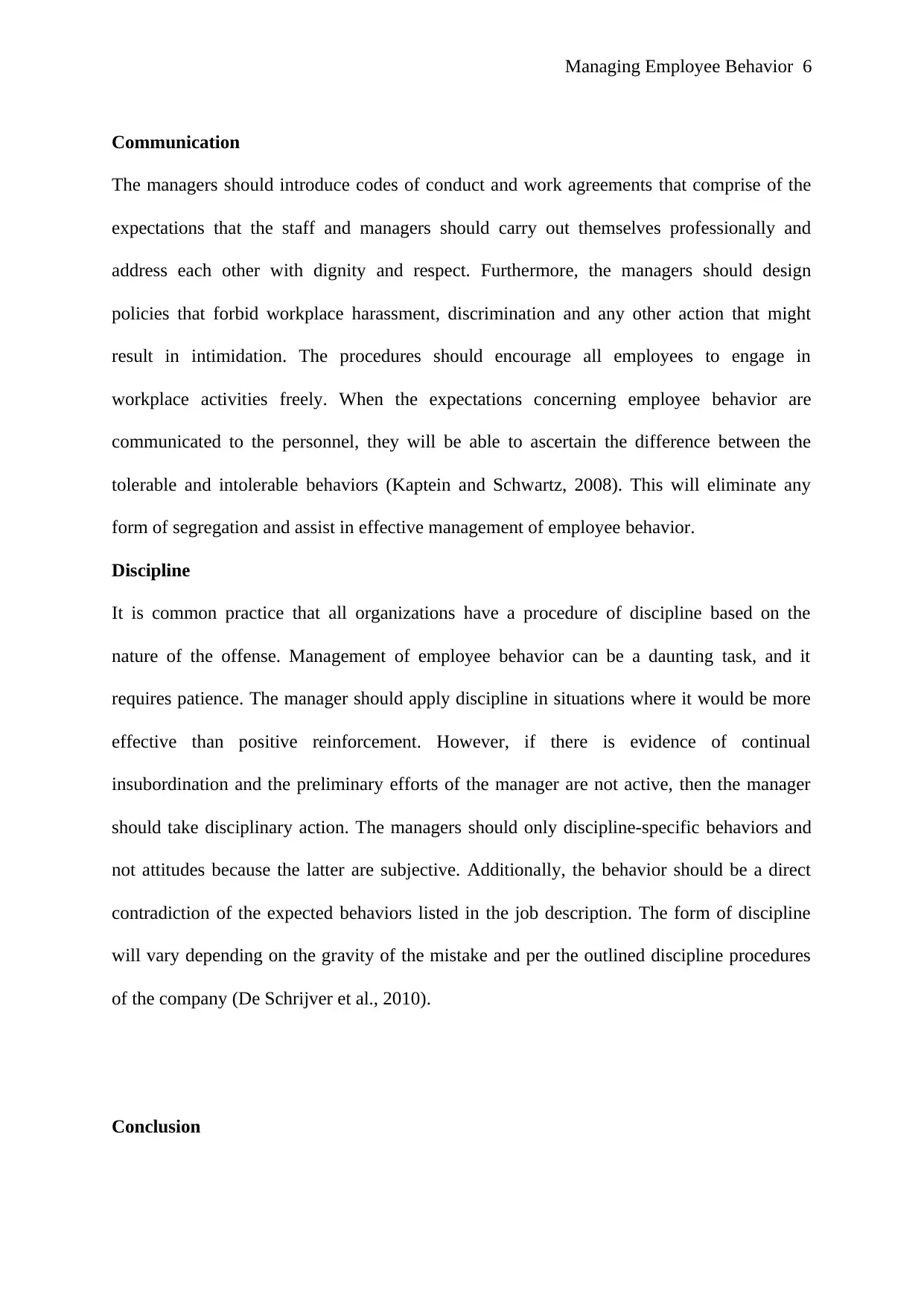
Managing Employee Behavior 6
Communication
The managers should introduce codes of conduct and work agreements that comprise of the
expectations that the staff and managers should carry out themselves professionally and
address each other with dignity and respect. Furthermore, the managers should design
policies that forbid workplace harassment, discrimination and any other action that might
result in intimidation. The procedures should encourage all employees to engage in
workplace activities freely. When the expectations concerning employee behavior are
communicated to the personnel, they will be able to ascertain the difference between the
tolerable and intolerable behaviors (Kaptein and Schwartz, 2008). This will eliminate any
form of segregation and assist in effective management of employee behavior.
Discipline
It is common practice that all organizations have a procedure of discipline based on the
nature of the offense. Management of employee behavior can be a daunting task, and it
requires patience. The manager should apply discipline in situations where it would be more
effective than positive reinforcement. However, if there is evidence of continual
insubordination and the preliminary efforts of the manager are not active, then the manager
should take disciplinary action. The managers should only discipline-specific behaviors and
not attitudes because the latter are subjective. Additionally, the behavior should be a direct
contradiction of the expected behaviors listed in the job description. The form of discipline
will vary depending on the gravity of the mistake and per the outlined discipline procedures
of the company (De Schrijver et al., 2010).
Conclusion
Communication
The managers should introduce codes of conduct and work agreements that comprise of the
expectations that the staff and managers should carry out themselves professionally and
address each other with dignity and respect. Furthermore, the managers should design
policies that forbid workplace harassment, discrimination and any other action that might
result in intimidation. The procedures should encourage all employees to engage in
workplace activities freely. When the expectations concerning employee behavior are
communicated to the personnel, they will be able to ascertain the difference between the
tolerable and intolerable behaviors (Kaptein and Schwartz, 2008). This will eliminate any
form of segregation and assist in effective management of employee behavior.
Discipline
It is common practice that all organizations have a procedure of discipline based on the
nature of the offense. Management of employee behavior can be a daunting task, and it
requires patience. The manager should apply discipline in situations where it would be more
effective than positive reinforcement. However, if there is evidence of continual
insubordination and the preliminary efforts of the manager are not active, then the manager
should take disciplinary action. The managers should only discipline-specific behaviors and
not attitudes because the latter are subjective. Additionally, the behavior should be a direct
contradiction of the expected behaviors listed in the job description. The form of discipline
will vary depending on the gravity of the mistake and per the outlined discipline procedures
of the company (De Schrijver et al., 2010).
Conclusion
⊘ This is a preview!⊘
Do you want full access?
Subscribe today to unlock all pages.

Trusted by 1+ million students worldwide
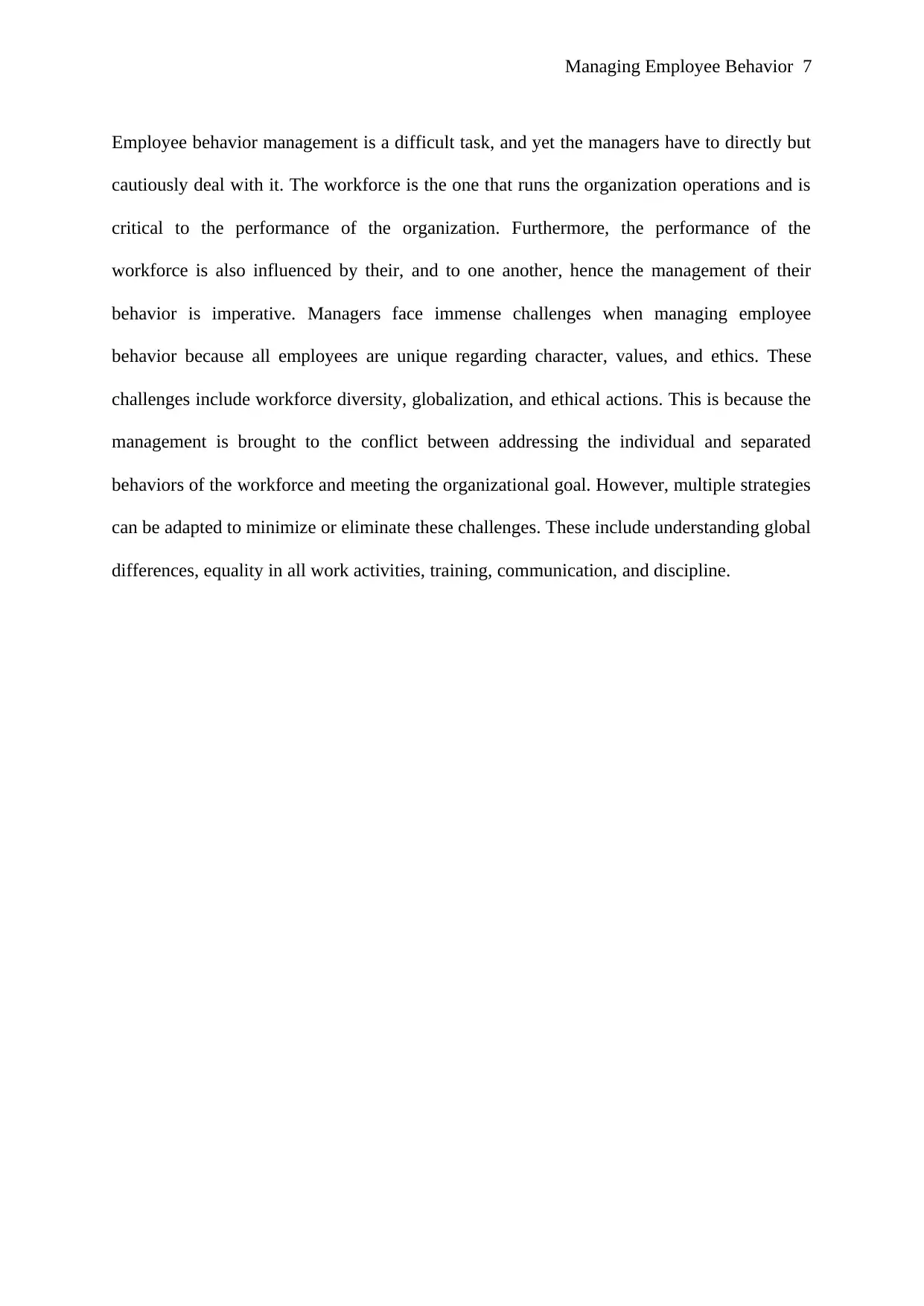
Managing Employee Behavior 7
Employee behavior management is a difficult task, and yet the managers have to directly but
cautiously deal with it. The workforce is the one that runs the organization operations and is
critical to the performance of the organization. Furthermore, the performance of the
workforce is also influenced by their, and to one another, hence the management of their
behavior is imperative. Managers face immense challenges when managing employee
behavior because all employees are unique regarding character, values, and ethics. These
challenges include workforce diversity, globalization, and ethical actions. This is because the
management is brought to the conflict between addressing the individual and separated
behaviors of the workforce and meeting the organizational goal. However, multiple strategies
can be adapted to minimize or eliminate these challenges. These include understanding global
differences, equality in all work activities, training, communication, and discipline.
Employee behavior management is a difficult task, and yet the managers have to directly but
cautiously deal with it. The workforce is the one that runs the organization operations and is
critical to the performance of the organization. Furthermore, the performance of the
workforce is also influenced by their, and to one another, hence the management of their
behavior is imperative. Managers face immense challenges when managing employee
behavior because all employees are unique regarding character, values, and ethics. These
challenges include workforce diversity, globalization, and ethical actions. This is because the
management is brought to the conflict between addressing the individual and separated
behaviors of the workforce and meeting the organizational goal. However, multiple strategies
can be adapted to minimize or eliminate these challenges. These include understanding global
differences, equality in all work activities, training, communication, and discipline.
Paraphrase This Document
Need a fresh take? Get an instant paraphrase of this document with our AI Paraphraser
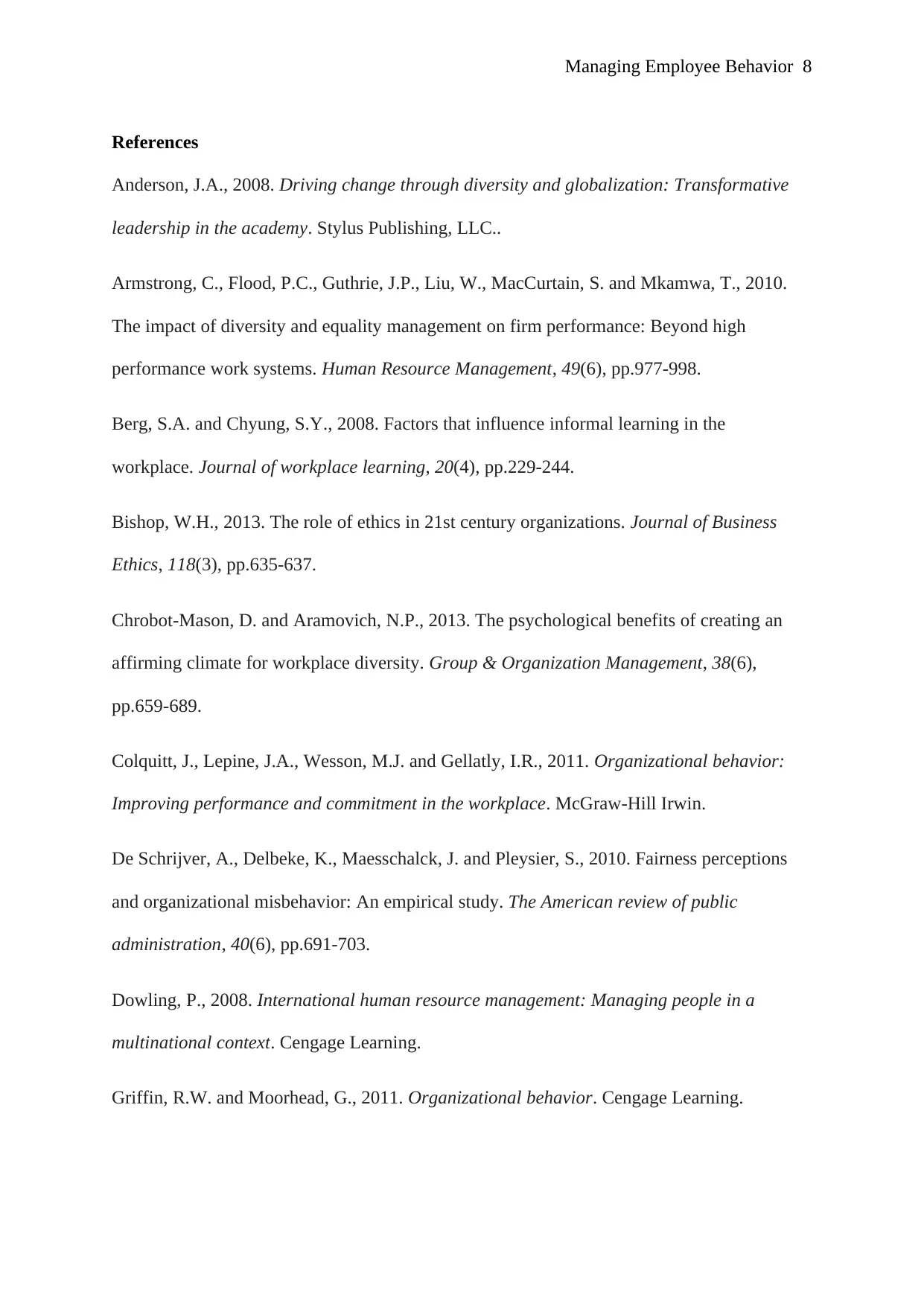
Managing Employee Behavior 8
References
Anderson, J.A., 2008. Driving change through diversity and globalization: Transformative
leadership in the academy. Stylus Publishing, LLC..
Armstrong, C., Flood, P.C., Guthrie, J.P., Liu, W., MacCurtain, S. and Mkamwa, T., 2010.
The impact of diversity and equality management on firm performance: Beyond high
performance work systems. Human Resource Management, 49(6), pp.977-998.
Berg, S.A. and Chyung, S.Y., 2008. Factors that influence informal learning in the
workplace. Journal of workplace learning, 20(4), pp.229-244.
Bishop, W.H., 2013. The role of ethics in 21st century organizations. Journal of Business
Ethics, 118(3), pp.635-637.
Chrobot-Mason, D. and Aramovich, N.P., 2013. The psychological benefits of creating an
affirming climate for workplace diversity. Group & Organization Management, 38(6),
pp.659-689.
Colquitt, J., Lepine, J.A., Wesson, M.J. and Gellatly, I.R., 2011. Organizational behavior:
Improving performance and commitment in the workplace. McGraw-Hill Irwin.
De Schrijver, A., Delbeke, K., Maesschalck, J. and Pleysier, S., 2010. Fairness perceptions
and organizational misbehavior: An empirical study. The American review of public
administration, 40(6), pp.691-703.
Dowling, P., 2008. International human resource management: Managing people in a
multinational context. Cengage Learning.
Griffin, R.W. and Moorhead, G., 2011. Organizational behavior. Cengage Learning.
References
Anderson, J.A., 2008. Driving change through diversity and globalization: Transformative
leadership in the academy. Stylus Publishing, LLC..
Armstrong, C., Flood, P.C., Guthrie, J.P., Liu, W., MacCurtain, S. and Mkamwa, T., 2010.
The impact of diversity and equality management on firm performance: Beyond high
performance work systems. Human Resource Management, 49(6), pp.977-998.
Berg, S.A. and Chyung, S.Y., 2008. Factors that influence informal learning in the
workplace. Journal of workplace learning, 20(4), pp.229-244.
Bishop, W.H., 2013. The role of ethics in 21st century organizations. Journal of Business
Ethics, 118(3), pp.635-637.
Chrobot-Mason, D. and Aramovich, N.P., 2013. The psychological benefits of creating an
affirming climate for workplace diversity. Group & Organization Management, 38(6),
pp.659-689.
Colquitt, J., Lepine, J.A., Wesson, M.J. and Gellatly, I.R., 2011. Organizational behavior:
Improving performance and commitment in the workplace. McGraw-Hill Irwin.
De Schrijver, A., Delbeke, K., Maesschalck, J. and Pleysier, S., 2010. Fairness perceptions
and organizational misbehavior: An empirical study. The American review of public
administration, 40(6), pp.691-703.
Dowling, P., 2008. International human resource management: Managing people in a
multinational context. Cengage Learning.
Griffin, R.W. and Moorhead, G., 2011. Organizational behavior. Cengage Learning.
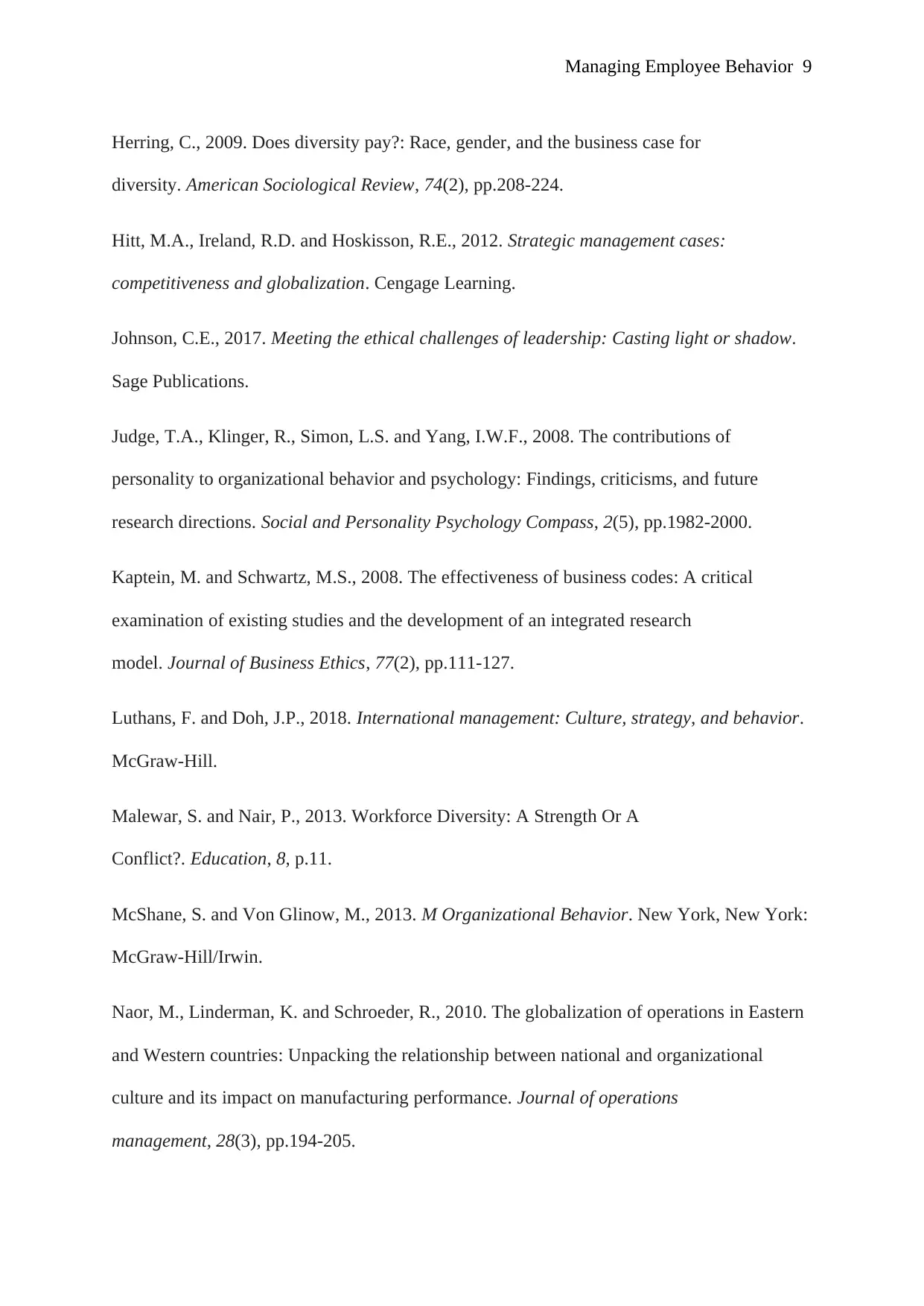
Managing Employee Behavior 9
Herring, C., 2009. Does diversity pay?: Race, gender, and the business case for
diversity. American Sociological Review, 74(2), pp.208-224.
Hitt, M.A., Ireland, R.D. and Hoskisson, R.E., 2012. Strategic management cases:
competitiveness and globalization. Cengage Learning.
Johnson, C.E., 2017. Meeting the ethical challenges of leadership: Casting light or shadow.
Sage Publications.
Judge, T.A., Klinger, R., Simon, L.S. and Yang, I.W.F., 2008. The contributions of
personality to organizational behavior and psychology: Findings, criticisms, and future
research directions. Social and Personality Psychology Compass, 2(5), pp.1982-2000.
Kaptein, M. and Schwartz, M.S., 2008. The effectiveness of business codes: A critical
examination of existing studies and the development of an integrated research
model. Journal of Business Ethics, 77(2), pp.111-127.
Luthans, F. and Doh, J.P., 2018. International management: Culture, strategy, and behavior.
McGraw-Hill.
Malewar, S. and Nair, P., 2013. Workforce Diversity: A Strength Or A
Conflict?. Education, 8, p.11.
McShane, S. and Von Glinow, M., 2013. M Organizational Behavior. New York, New York:
McGraw-Hill/Irwin.
Naor, M., Linderman, K. and Schroeder, R., 2010. The globalization of operations in Eastern
and Western countries: Unpacking the relationship between national and organizational
culture and its impact on manufacturing performance. Journal of operations
management, 28(3), pp.194-205.
Herring, C., 2009. Does diversity pay?: Race, gender, and the business case for
diversity. American Sociological Review, 74(2), pp.208-224.
Hitt, M.A., Ireland, R.D. and Hoskisson, R.E., 2012. Strategic management cases:
competitiveness and globalization. Cengage Learning.
Johnson, C.E., 2017. Meeting the ethical challenges of leadership: Casting light or shadow.
Sage Publications.
Judge, T.A., Klinger, R., Simon, L.S. and Yang, I.W.F., 2008. The contributions of
personality to organizational behavior and psychology: Findings, criticisms, and future
research directions. Social and Personality Psychology Compass, 2(5), pp.1982-2000.
Kaptein, M. and Schwartz, M.S., 2008. The effectiveness of business codes: A critical
examination of existing studies and the development of an integrated research
model. Journal of Business Ethics, 77(2), pp.111-127.
Luthans, F. and Doh, J.P., 2018. International management: Culture, strategy, and behavior.
McGraw-Hill.
Malewar, S. and Nair, P., 2013. Workforce Diversity: A Strength Or A
Conflict?. Education, 8, p.11.
McShane, S. and Von Glinow, M., 2013. M Organizational Behavior. New York, New York:
McGraw-Hill/Irwin.
Naor, M., Linderman, K. and Schroeder, R., 2010. The globalization of operations in Eastern
and Western countries: Unpacking the relationship between national and organizational
culture and its impact on manufacturing performance. Journal of operations
management, 28(3), pp.194-205.
⊘ This is a preview!⊘
Do you want full access?
Subscribe today to unlock all pages.

Trusted by 1+ million students worldwide
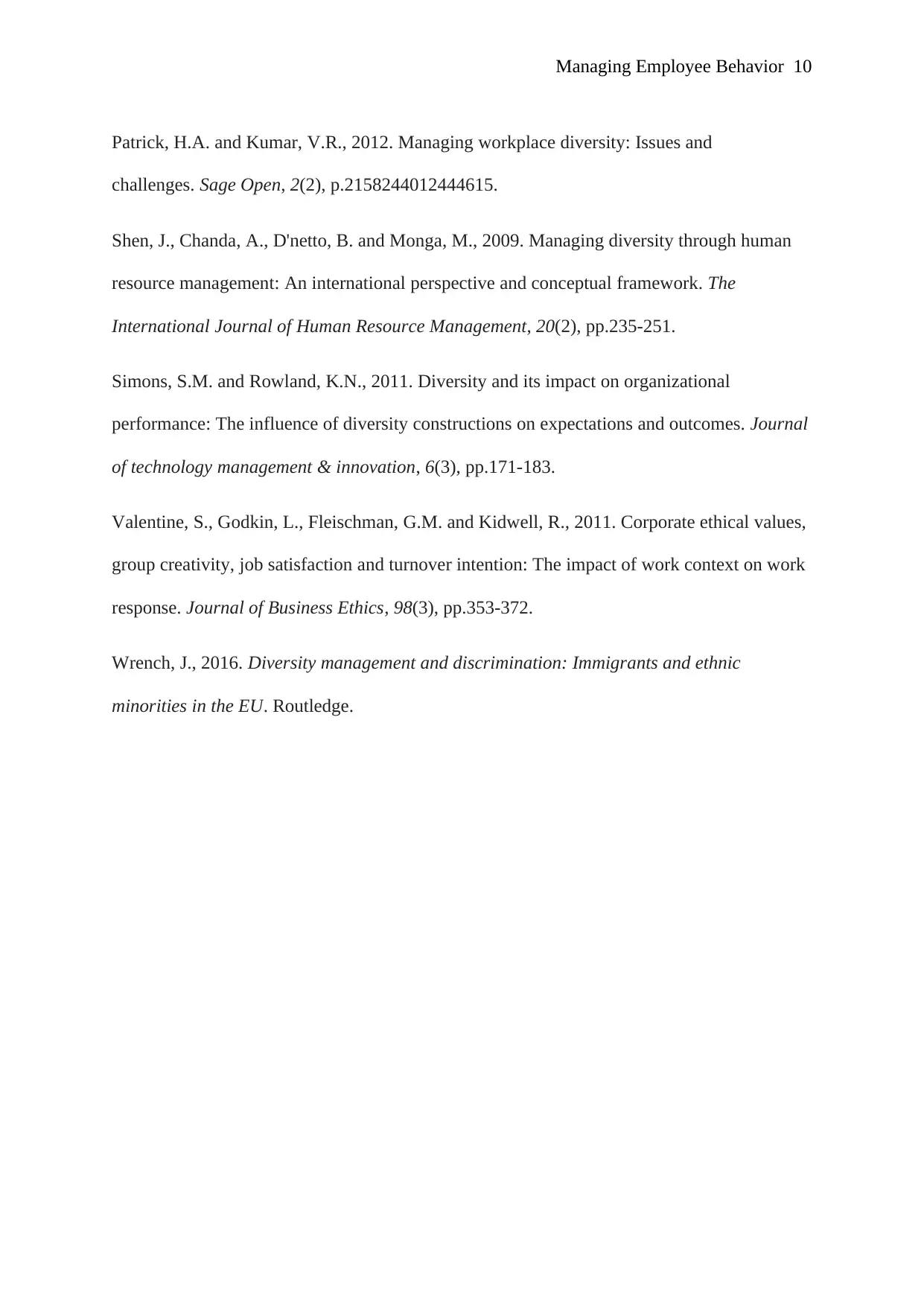
Managing Employee Behavior 10
Patrick, H.A. and Kumar, V.R., 2012. Managing workplace diversity: Issues and
challenges. Sage Open, 2(2), p.2158244012444615.
Shen, J., Chanda, A., D'netto, B. and Monga, M., 2009. Managing diversity through human
resource management: An international perspective and conceptual framework. The
International Journal of Human Resource Management, 20(2), pp.235-251.
Simons, S.M. and Rowland, K.N., 2011. Diversity and its impact on organizational
performance: The influence of diversity constructions on expectations and outcomes. Journal
of technology management & innovation, 6(3), pp.171-183.
Valentine, S., Godkin, L., Fleischman, G.M. and Kidwell, R., 2011. Corporate ethical values,
group creativity, job satisfaction and turnover intention: The impact of work context on work
response. Journal of Business Ethics, 98(3), pp.353-372.
Wrench, J., 2016. Diversity management and discrimination: Immigrants and ethnic
minorities in the EU. Routledge.
Patrick, H.A. and Kumar, V.R., 2012. Managing workplace diversity: Issues and
challenges. Sage Open, 2(2), p.2158244012444615.
Shen, J., Chanda, A., D'netto, B. and Monga, M., 2009. Managing diversity through human
resource management: An international perspective and conceptual framework. The
International Journal of Human Resource Management, 20(2), pp.235-251.
Simons, S.M. and Rowland, K.N., 2011. Diversity and its impact on organizational
performance: The influence of diversity constructions on expectations and outcomes. Journal
of technology management & innovation, 6(3), pp.171-183.
Valentine, S., Godkin, L., Fleischman, G.M. and Kidwell, R., 2011. Corporate ethical values,
group creativity, job satisfaction and turnover intention: The impact of work context on work
response. Journal of Business Ethics, 98(3), pp.353-372.
Wrench, J., 2016. Diversity management and discrimination: Immigrants and ethnic
minorities in the EU. Routledge.
1 out of 10
Related Documents
Your All-in-One AI-Powered Toolkit for Academic Success.
+13062052269
info@desklib.com
Available 24*7 on WhatsApp / Email
![[object Object]](/_next/static/media/star-bottom.7253800d.svg)
Unlock your academic potential
Copyright © 2020–2025 A2Z Services. All Rights Reserved. Developed and managed by ZUCOL.





